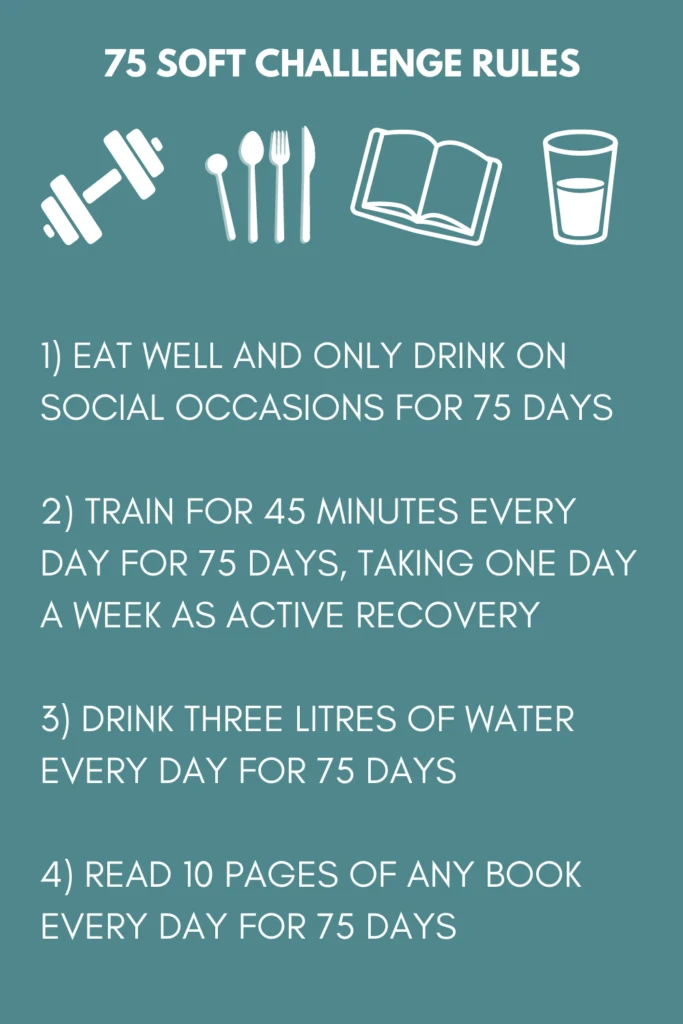If you’re on TikTok then you may already be familiar with the 75 Soft Challenge.
The viral health and wellness trend has taken the internet by storm over the last few years – with videos of people doing the challenge racking up millions of views on social media.
Like the challenges that have come before it, its overall aim is to get you to develop a well-rounded, healthy routine which includes both workouts, healthy eating and mindful habits.
So if you struggle to stick with healthy habits and often find them falling by the wayside, then this may be the challenge for you.
But what exactly does the challenge involve? What are its benefits and risks? And how do you do it?
In this guide we’ll explore:
- What is the 75 Soft Challenge?
- What are the 75 Soft Challenge rules?
- What are the benefits of the 75 Soft Challenge?
- What are the differences between the 75 Soft and 75 Hard Challenge?
- What are the risks surrounding the 75 Soft Challenge?
- 75 Soft Challenge Q&A
- 75 Soft Challenge: How do it
Ready?
Let’s get started!

What is the 75 Soft Challenge?
The 75 Soft Challenge is a viral health and fitness trend that is making its rounds on social media sites like TikTok.
Essentially, it’s a challenge that aims to get you to start and stick with healthy habits over a period of 75 days.
The 75 Soft Challenge was created in 2019 by the lifestyle site The Pohhu Experience.
The challenge largely came about in response to the 72 Hard Challenge which was created by entrepreneur Andy Frisella.
Frisella describes the 75 Hard Challenge as a “transformative mental toughness programme”, not a fitness programme.
As we explain later in this guide, the 75 Hard Challenge has a much stricter set of rules to follow.
The 75 Soft Challenge claims to be a more realistic challenge to follow:
The creator of the 75 Soft Challenge said: “75 Hard wasn’t realistic at that moment in time for me, but I still wanted something to pull me back into the right direction, and so 75 Soft was born.”
Adding that: “The rules are simple, you have a list of things to complete every single day for 75 days. The hard version makes zero exceptions for off days, but with the soft version there will be a few exceptions.”
Related: The ultimate 30 day workout challenge for runners
What are the 75 Soft Challenge rules?
The 75 Soft Challenge has four key rules:
- Eat well and only drink on social occasions for 75 days.
- Train for 45 minutes every day for 75 days, taking one day a week as active recovery.
- Drink three litres of water every day for 75 days.
- Read 10 pages of any book every day for 75 days.

#1 Eat well and only drink on social occasions for 75 days
The challenge doesn’t prescribe a specific diet. You simply need to ‘eat well’ – that is stick to a healthy diet – for 75 days.
This means you make the rules and set the boundaries when it comes to healthy eating.
Whether this means limiting your calorie intake or adding more fruit and vegetables in your diet, you decide.
The key is that you stick to these healthy habits for the 75 day period.
The challenge also says that you need to limit alcohol consumption to social occasions only.
This, however, doesn’t mean you can drink as much as you want when you’re out and about as this would derail your healthy eating plans entirely.
#2 Train for 45 minutes every day for 75 days, taking one day a week as a recovery day
The workout section of the challenge is probably what gets the most attention as it’s easy to share and track your progress when it comes to exercise.
The challenge prescribes a 45-minute workout every day, with one active recovery day per week.
Depending on your personal preferences, you may decide to dedicate your workout to cardio like running, cycling or swimming or to activities like strength training or high intensity training.
The active recovery day should focus on low impact, low intensity activities like walking, yoga or Pilates.
The great thing about the 75 soft challenge is that you get to choose the activity.
#3 Drink three litres of water every day for 75 days
There’s no doubt that drinking enough water every day is a healthy habit that we can all prescribe to.
Various studies show the importance of staying hydrated when leading an active lifestyle.
It’s important to replace fluids lost through sweat when you exercise.
Your mind and body cannot function properly when you show symptoms of dehydration – such as dark urine and lack of sweat when exercising.
Three litres of water equals 12 cups of water a day.
If you’re nowhere near drinking this amount of water currently, then the challenge is a good way to make sure you’re getting your daily intake of H20.
#4 Read 10 pages of any book every day for 75 days
One of the surprising things about this challenge is that it gets you reading on a daily basis.
Studies tell us that reading, along with activities like yoga and laughing, have a positive impact on stress levels.
One 2009 study concluded that one 30-minute session of yoga, humour and reading had similar effects in decreasing acute stress in health science students.
The bottom line? Making time for a mindful activity like reading is an excellent way to unwind and de-stress.
Related: The best HIIT running workouts to do today to lose weight

What are the benefits of the 75 Soft Challenge?
Here are some of the benefits of the 75 Soft Challenge:
#1 It gets you moving
One of the biggest benefits of the 75 Soft Challenge is that it gets you moving.
In the age of the desk job, it can be all too easy to sit at home all day.
By doing 45 minutes worth of exercise each day, you will become more active which has many benefits for your physical and mental health.
#2 It gets you making healthy changes to your eating habits
The challenge also gets you to make healthy changes to your eating habits.
Whether that be eating more fruit and vegetables or adding more protein into your diet – it’s really up to you and your personal preferences.
#3 It gets you drinking more water
Drinking water daily is also a huge plus for this challenge as you may agree that many of us are guilty of not drinking enough water.
As we discussed earlier, staying hydrated is crucial, especially if you lead an active lifestyle.
#4 It gets you doing more mindful activities
Reading is a great mindful activity to do either at the start of your day or just before bedtime to send you off to sleep.
Research tells us that scrolling through social media before bedtime is bad for your health, so making time for reading is a great way to set yourself up for a good night’s sleep.
Whether you choose a fiction or non-fiction book that is completely up to you!
Related: The ultimate 30 day strength training plan for runners
What are the differences between the 75 Soft and 75 Hard Challenge?
The 75 Soft Challenge came about as a result of the 75 Hard Challenge.
The 75 Hard Challenge has the following rules:
- Train for 45 minutes twice a day every day for 75 days. One of these workouts must be outdoors.
- Follow a diet. The diet must be a structured eating plan with the goal of physical improvement. No alcohol or meals outside your chosen diet are allowed.
- Take a progress picture.
- Drink one gallon (3.7 litres) of water every day for 75 days.
- Read 10 pages of a book every day for 75 days.
Many people feel the 75 Soft Challenge is more practical and realistic compared with the 75 Hard Challenge.
For example, working out for 45 minutes twice a day is a huge time commitment.
It can also be difficult to do an outdoors workout in the winter months.
Here are some other reasons why the 75 Soft Challenge is more practical:
- The 75 Soft Challenge isn’t as strict. If you miss any of the rules or miss a day, it doesn’t kick you back to Day 1.
- The 75 Soft Challenge aims for consistency instead of perfection.
- The 75 Soft Challenge is easier to fit into a busy schedule.
- The 75 Soft Challenge focuses on small changes which are easier to implement and stick with.
Related: The ultimate 14 day strength training plan for runners

Related: Nude running: Everything you need to know
What are the risks surrounding the 75 Soft Challenge?
Despite the benefits of the 75 Soft Challenge, there are some pitfalls of the challenge which we explain more about below.
#1 It doesn’t cater for individual requirements
Everyone has their own set of unique wants and needs when it comes to health and fitness, so asking every individual to do the same challenge has its flaws.
Many people turn to structured and tailored training and eating plans when they have specific dietary or exercise requirements.
For example:
- If you’re returning to exercise following an injury, then the challenge is best avoided because you don’t want to be exercising every day of the week.
- If you have certain weight loss goals, then the recommendation would be to follow a calorie-restricted diet instead in order to see results. This may require further guidance and support from a personal trainer and nutritionist.
- If you’re a complete beginner and lead a sedentary lifestyle currently, then exercising every day may be too much for you. It’s better to gently ease yourself into an exercise routine and take plenty of rest days to avoid overtraining, disappointment and burnout.
It’s worth noting that you can choose how to interpret the challenge based on your personal preferences.
However, if you’re looking for a more structured plan with more defined guidance when it comes to exercise and nutrition, then this may not be the best challenge for you.
#2 It gets you exercising every day of the week
Some people would argue that exercising every day of the week is too much and that your body needs more rest and recovery time in order to prevent burnout, overtraining and overuse injuries.
Most well-rounded training plans will include at least two rest days to allow your body to recover in between runs and workouts.
This is especially true if you are training for a long distance event like a half marathon or marathon.
So when it comes to the exercise portion of the challenge, take it with a pinch of salt and ensure you don’t push yourself too hard.
Always listen to your body and do what’s right for you.
#3 It encourages obsessive patterns and routines
Although the Soft Challenge isn’t as rigorous as its counterpart the Hard Challenge, some would argue that the challenge encourages an unhealthy obsession with dieting and exercise.
Whilst having a routine is important when it comes to forming new habits, there is a tipping point when exercise turns into compulsive exercise (otherwise known as exercise addiction).
People who feel pressure to stay in shape are at risk of developing exercise addiction, and exercise addiction happens when you are driven to exercise too much.
Injury, illness, socialising, or bad weather do not get in the way of someone exercising if they have an obsession with it.
Research tells us that compulsive exercise and eating disorders often happen together.
According to a 2019 study, “in a society that perpetuates the perfect appearance, a fit body has become synonymous with success, but is simultaneously hard to achieve. This represents fertile ground for the development of exercise addiction alongside other disorders such as body dysmorphic disorder.”
The study identified a high risk of exercise addiction, appearance anxiety and body dysmorphic disorder amongst gym users internationally.
Adding that there is an association between these disorders and the unsupervised use of a variety of fitness products, and highlighted the need for informed and integrated responses targeting such vulnerable individuals.
The bottom line? The 72 Soft Challenge could pave the way for individuals to develop an unhealthy obsession with exercise.
If in doubt, speak to a professional about forming healthy exercise and eating habits.
Related: Is it safe to lose 30 pounds in 30 days? Your questions answered
75 Soft Challenge Q&A
Q: Can I skip one or more of the rules in the 75 Soft Challenge?
A: Although you are free to skip some of the rules, if you do skip one or more of the rules, then you won’t be completing the true challenge.
In order to complete the challenge successfully, you must follow all the rules.
Q: Will I lose weight doing the 75 Soft Challenge?
A: Yes, weight loss is possible depending on your habits. Typically, in order to lose weight, you need to follow a calorie-restricted diet and combine this with exercise like cardio and strength training.
High intensity training is particularly effective to help you burn calories, so it’s recommended you include this type of training in the challenge.
Q: What type of book should I read?
A: Unlike the 75 Hard Challenge, there are no defined rules around what books you should read.
So it is really down to your personal preferences in terms of what you choose to read during the challenge.
Some people choose non-fiction or self-help books, whereas others opt for fiction books to escape.
Related: Walking 4 miles a day: Is it good for weight loss?

75 Soft Challenge: How do it
Using the rules of the challenge, we have created an example 7-day plan to show you what is possible with the challenge.
Of course, if you have specific dietary requirements, then feel free to swap out some of the recipes.
Likewise, if you have a preference in terms of exercise, swap out the workouts too.
You can also choose when to exercise and when to read a book.
Day 1:
- 45-minute run
- Breakfast: Scrambled eggs on wholemeal toast
- Mid-morning snack: Handful of blueberries with Greek yoghurt
- Lunch: Grilled chicken with rice and greens
- Mid-afternoon snack: Apple with peanut butter
- Dinner: Vegetable chilli with brown rice
- Read 10 pages of a book before bedtime
- Drink three litres of water throughout the day
Day 2:
- 45-minute run
- Breakfast: Porridge with a milk of your choice
- Mid-morning snack: Handful of nuts
- Lunch: Tuna sandwich on wholemeal bread
- Mid-afternoon snack: Handful of berries with Greek Yoghurt
- Dinner: Grilled salmon with greens
- Read 10 pages of a book before bedtime
- Drink three litres of water throughout the day
Day 3:
- 45-minute yoga session
- Breakfast: Bircher muesli
- Mid-morning snack: Handful of berries with Greek yoghurt
- Lunch: Ham and cheese omelette with vine ripened tomatoes
- Mid-afternoon snack: 2 squares of dark chocolate
- Dinner: Grilled tuna with greens
- Read 10 pages of a book before bedtime
- Drink three litres of water throughout the day
Day 4:
- 45 minute strength training session
- Breakfast: Scrambled eggs on wholemeal toast
- Mid-morning snack: Handful of nuts
- Lunch: Grilled chicken with rice and greens
- Mid-afternoon snack: Apple with peanut butter
- Dinner: Butternut squash curry with brown rice
- Read 10 pages of a book before bedtime
- Drink three litres of water throughout the day
Day 5:
- 45 minute run
- Breakfast: Overnight oats
- Mid-morning snack: Handful of blueberries with Greek yoghurt
- Lunch: Chicken salad sandwich
- Mid-afternoon snack: 2 squares of dark chocolate
- Dinner: Vegetable lasagne with salad
- Read 10 pages of a book before bedtime
- Drink three litres of water throughout the day
Day 6:
- Active recovery (e.g. 45 minute walk)
- Breakfast: Red pepper and chorizo omelette
- Mid-morning snack: Handful of nuts
- Lunch: Tofu with sesame noodles
- Mid-afternoon snack: Apple with peanut butter
- Dinner: Grilled chicken with rice and greens
- Read 10 pages of a book before bedtime
- Drink three litres of water throughout the day
Day 7:
- 45 minute strength training session
- Breakfast: Porridge
- Mid-morning snack: Fruit and nut bar
- Lunch: Grilled salmon with greens
- Mid-afternoon snack:
- Dinner: Vegetable chilli with brown rice
- Read 10 pages of a book before bedtime
- Drink three litres of water throughout the day
- 5 things I wish I’d known before returning to running - March 3, 2024
- Running 20 minutes a day: Benefits + how to start - January 27, 2024
- How to run your first 2 hour half marathon - January 16, 2024
